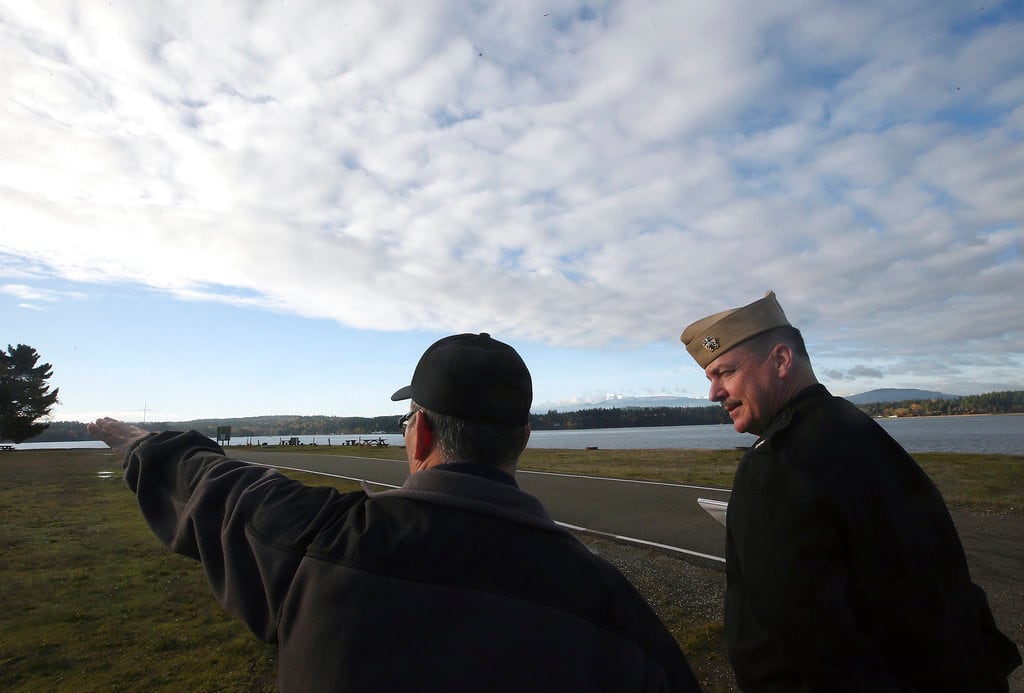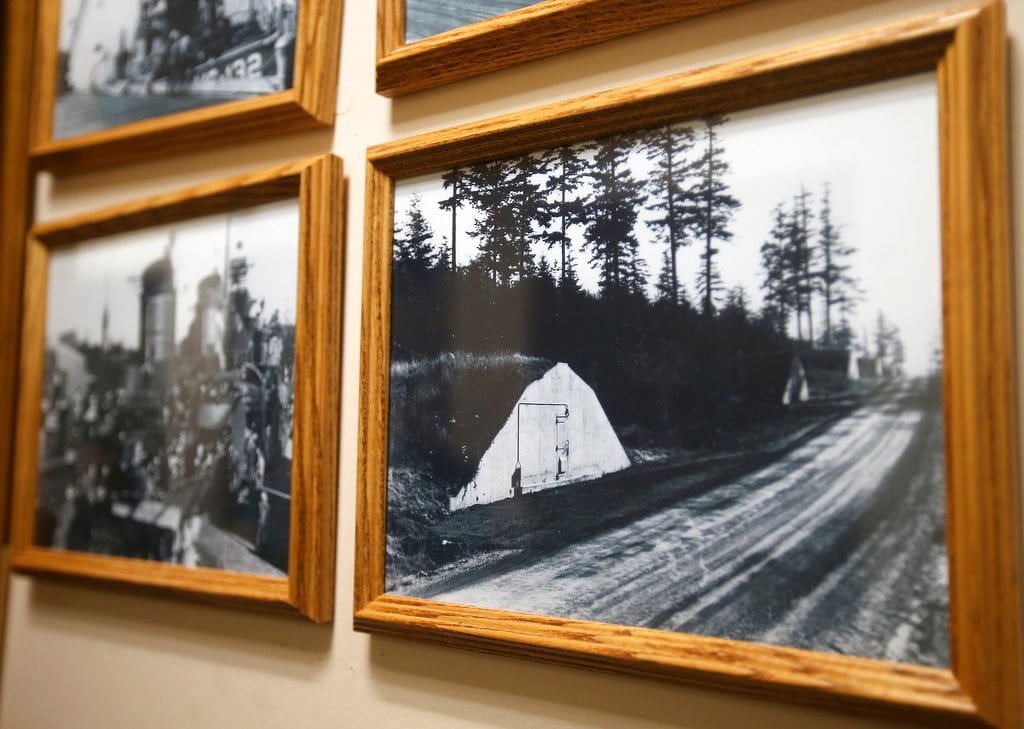BREMERTON, Wash. — Tucked away off the forested Jefferson County coastline 20 miles north of the Hood Canal Bridge, there’s a little-known Navy installation that serves as the “logistics backbone” for ships heading out to the Pacific Ocean.
Naval Magazine Indian Island serves as the last stop for many ships where they load up on “fuel, food and munitions” before heading out to the open ocean, said Cmdr. Rocky Pulley, commanding officer of the installation.
“Naval Magazine Indian Island plays a huge role in supporting our troops abroad, going west, all the way to the Persian Gulf,” Pulley said.
It has more than 100 magazines that store conventional weapons, ranging from small arms ammunition to aircraft ordnance.
The magazines, which are colloquially called “igloos,” are concrete, dome-like above-ground structures covered with grass. Smaller ones require munitions to be carried in by hand. The large ones can fit a forklift inside.
Naval Magazine Indian Island is the only deep water ordnance facility on the West Coast with no access restrictions, such as shallow bridges or water. The island has a 1,650-foot-long pier with 55 feet of draft available at the average low-tide height of water, making it so the Navy can load munitions onto any vessel in the fleet docked at the island’s pier.
An average of 50 aircraft carriers, ammo ships, guided-missile destroyers, guided-missile submarines, U.S. Coast Guard patrol boats, commercial barges, container ships and other Navy vessels visit the island each year.
“There’s nothing that leaves the Northwest region that doesn’t come by NAVMAG Indian Island or isn’t serviced at sea with conventional ordnance that’s supplied by Indian Island,” Pulley said.
Each type of ship has specific procedures for loading and unloading ordnance, depending on the size and type of vessel, Pulley said.
An aircraft carrier has a large open hangar deck with hundreds of personnel who can load large amounts of ammo on pallets or in containers in a matter of about 10 to 12 hours.
For destroyers and cruisers with vertical launch systems, they require a more complex process to load ordnance with specialized handling equipment. It can take a few days to load one of these vessels, sometimes requiring up to three of the mobile cranes on the island to hoist ordnance into tight spots.
For submarines, a full load-out can take five to six days, depending on how many torpedo tubes the boat has.
“There’s a ramp that goes down in a 45-degree angle that you load the torpedo on with a cable and pulley system that lowers it down into the spaces and you bring it back up,” Pulley said. “It’s just one at a time.”

The island is home to the Department of Defense’s largest container crane, called “Big Blue” for the pastel blue coat of paint on the metal behemoth. The diesel-electric-powered crane can lift 89,000 pounds of munitions and ordnance from the ammo pier to whatever vessel is docked there.
A typical work day on the island begins at 6:30 a.m. and runs until about 4 p.m., although the operational schedule can shift depending on what’s happening down at the ammo pier. Security operations on the island and in the water surrounding it run around the clock, seven days a week.
About 160 people work on the island, including 18 military personnel, 95 civilians, 56 contractors and 109 Navy reservists. There isn’t any housing on the island, so all of the employees commute to the island every morning, some from neighboring Port Townsend or Marrowstone Island, others from as far as Bremerton and Silverdale.
A REFUGE FOR WILDLIFE
Pulley, who assumed command of the installation in June, said one of his favorite things to do on a Friday is to hop in a Jeep and drive all over the island.
“I want to get to know every inch of the island,” Pulley said. “There’s still so much I want to see.”
More than 2,100 acres of the overall 2,700-acre island is almost untouched forest land.
“Because we don’t build in between the magazines, that leaves forested areas with old growth-trees that make great wildlife habitats,” said Environmental Manager Bill Kalina. “The entire island is kind of like a refuge for wildlife.”
Deer roam the island, as well as cougars, bears and snakes. There are 10 active bald eagle nests across the island, some of which date the back to the late 1970s, Kalina said.
The Navy employs many practices to protect and foster the island’s rich natural beauty.

Through the hard work of the command’s two-person environmental team, Naval Magazine Indian Island was the third Navy installation to ever be removed from the Environmental Protection Agency’s Superfund clean-up list after successfully remediating 19 contaminated sites, including a former landfill and old munition disposal areas. To date, it is the only Navy installation on the West Coast to be removed from the Superfund list.
The Navy recently completed a $5 million upgrade to replace old diesel-powered generators for submarines docked at Indian Island’s ammo pier with a new, permanent shore-based electrical power system. The old generators were the top source of air pollution on the island, Kalina said.
The “much needed” upgrade eliminated the noise created by the old generator, which could be heard all the way in Port Townsend on a clear day. It also eliminated diesel fuel emissions to reduce the island’s carbon footprint.
The command’s efforts to reduce environmental impacts on the island has reduced its energy consumption by 61 percent since 2003. It’s earned it numerous government efficiency awards, including five consecutive platinum-level and a 2017 gold-level Secretary of the Navy Energy and Water Management awards.
THE PAST, PRESENT AND FUTURE
The Navy purchased the land on Indian Island from homesteaders in 1939 and began setting up shop on the island seven months before the Japanese attack on Pearl Harbor on Dec. 7, 1941.
Few remnants of the original homesteads still exist on the island today. There’s a fruit-bearing orchard that produces apples and plums, and the historic grave site of homesteader Maren J. Anderson of Denmark, who died in 1889, is located just south of where her house once stood.
Kalina said the command is also focused on fostering a good relationship with the S’Klallam Tribe, which predated the homesteaders on the island and lived side-by-side with them for a time. The S’Klallams have treaty-protected foraging and clam-harvesting rights on Indian Island in what are some of the “best clam beaches in the world,” Pulley said.
“Here they can harvest because we don’t spray (herbicide) on the island,” Kalina said. “So they come here to harvest cattails to make baskets, shoots to make traditional Native American food dishes and stinging nettle to make traditional balm. But the most important thing they do here is harvest cedar bark to make traditional hats, vests, all types of clothing.”
There are at least 14 documented Native American archaeological sites on the island and an untold number of burial sites.
Any discovered remains on the island are repatriated back to the S’Klallam Tribe and then reburied on Indian Island with a tribal ceremony.
“Prior to us establishing a reburial site on Navy land, there was no (mechanism for it).” Kalina said. “The tribes came to me... and said they wanted to put the ancestors back on the island because we don’t want to keep them in a warehouse in a box.”
And so, in 2000, Kalina went to the region’s Navy lawyer and undertook a three-and-a-half-year “saga,” to gain approval from the government to rebury the remains. Naval Magazine Indian Island was the first Navy installation to create such a program and has since established the precedent for others to follow suit.
Last summer, the command allowed youth from the Port Gamble S’Klallam Tribe to come to the island and land their canoes at Walan Point. That was the first time a native canoe had landed on Indian Island in 70 years.
“It was really cool,” Kalina said. “They did a welcoming ceremony with the drums as the kids came ashore.”
During World War II, Navy ships headed for the Pacific theater stopped at the island to be loaded with ordnance before heading out to sea. Large anti-submarine nets were also manufactured on the island and deployed in Puget Sound to prevent enemy vessel intrusion into the waterways.

At the height of the war, more than 350 military personnel and 200 civilians worked on the island to load vessels seven days a week, sometimes loading two ships a day.
Remnants of the installation’s increased activity during the war are a two-lane bowling alley and a bar with pool tables in the basement of the administration building.
As operations tapered off on the island, the magazine was placed on reduced operational status in 1959. But with the construction of the Trident Submarine Base at Bangor, the island was brought back to life as the conventional weapon storage moved back to the old magazines. A new ammo-loading wharf and additional magazines were built in 1978.
Pulley said the future of Indian Island will likely continue at the current operational level of the outpost.
“We might get a few more bodies, but our operation and the scope of the operation and our mission doesn’t change,” Pulley said. “It doesn’t matter what’s going on abroad, we still will do what we need to do here. We might see a few more ships here, but our role is still the same.”
Information from: Kitsap Sun





